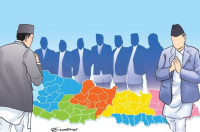Opinion
Broken links
Material rebuilding after a disaster needs to go hand in hand with the revamping of social and political arrangements
Bicram Rijal
Post-earthquake, Nepal is facing many challenges. One of them, of course, is disaster management. In Nepal, disaster management figures in everything—from academic researches to development programmes, from rebuilding houses to the reconstruction of public infrastructures and from political rhetoric to the discourses of social transformation. The biggest focus of the governmental and non-governmental organisations currently has been on humanitarian responses to the disaster, including ways to better manage the present and future disasters. But the question is: Are they identifying and addressing the disaster as a multifarious category or a singular one? So far, the ongoing disaster management has only focused on material and physical rebuilding and has failed to recognise the disaster’s multiple manifestation and its diverse implications on different communities and social groups.
Damodar Timilsina, a long-time development campaigner in Dolakha, argues that “simply building a fence and a wall will not bring a disaster to an end; addressing a disaster requires finding its different layers—familial, socio-cultural, financial and political—besides the physical and material.” He thinks that while being obsessed with the 2015 earthquakes, many of us forget the disasters resulting from climate change and a decade-long political conflict. Timilsina’s statements call for an examination and exploration of disasters’ historical past, not just their current manifestations. They also urge us to look into their social and political impacts along with the loss of physical infrastructures.
The narrow definition of a disaster that focuses on the loss of and damage to tangible things—residence buildings and heritage sites—hinders us from seeing people’s diverse experiences embedded in their varied existential circumstances made up of unique geographies, political and cultural processes, economies, and so on. These different circumstances affect the ways families and communities respond to a disaster. Because a disaster is fundamentally treated as a material loss, a devastation of a private house, a school or a hospital is perceived to capture the ‘real’ meaning of the disaster. On the other hand, the social and psychological sufferings, economic burdens, and political mishandling resulting from the material damage itself as well as from the government’s sluggish responses are either underestimated or rendered unimportant in public discourses of disaster management.
Pluralising disaster
The quakes should not be treated in a singular and decontextualised manner. A damage of a building or a loss of a relative cannot be the same for two individuals. Devastation of a health post in Dolakha bazaar cannot and should not be treated the same as in the remote Orang or Lamabagar Village Development Committee (VDC) of Dolakha district. A totally damaged health post in Gongar of Lamabagar means that the people of the village have to go all the way to Singati, which is a day’s walk if one does not get public transport, for a diagnosis or treatment.
For the residents of Dolakha bazaar, however, the loss of a health post building does not necessarily mean no access to health care. Private health clinics, pharmacies and hospitals in nearby Charikot provide the Dolakha bazaar residents with access to some form of health care even amidst the post-disaster chaos.
Rebuilding a house in a village of the Alampu VDC would require completely different financial, material and social arrangements than in Charikot of the same district. Factors such as transportation, affordability, geographical distance, distribution of government’s reconstruction grant, etc play a big part in how an individual decides to build a house, or not to build one.
Age-old suffering
The discourses on national and international media have often attempted to give us a false impression that last year’s quakes were the beginning of a humanitarian crisis and social suffering in Nepal. Nepalis have faced multiple crises throughout history. High levels of poverty, volatile politics, inefficient bureaucracy, and indifferent political leaders have traditionally forced Nepalis to live through acute shortages, difficulties and agonies. The claim that the earthquakes have brought a humanitarian crisis to Nepal is erroneous because floods, landslides, road accidents, poor health infrastructure and food scarcity have long contributed to thousands of deaths every year in the country. So our conceptualisation of disasters and crises needs thicker and deeper vocabularies. We need to recognise the explicit and implicit, physical and social, superficial and in-depth, and contemporary and historical manifestations of the disaster. Likewise, disaster management has to take the diversity of experiences embedded in geographical, social, cultural, political and ecological peculiarities into account.
Disaster management in Nepal needs to pay as much heed to the structural violence and inequalities, and power politics as to the physical and material repairs. The material rebuilding needs to go hand in hand with the revamping of social and political arrangements. The quakes have caused us a great damage, but they have also provided us with an historical opportunity to repair our bad arrangements—human, social, techno-material and political. Perhaps this is the best time for such a repair; we should not let this opportunity slip through our fingers.
Rijal is a PhD candidate in Anthropology at Simon Fraser University, Canada and can be reached at [email protected]




 18.12°C Kathmandu
18.12°C Kathmandu










